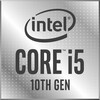Intel Core i5-1038NG7 vs Apple M1 Pro vs Apple M1 Pro 8-Core
Intel Core i5-1038NG7
► remove from comparison
The Intel Core i5-1038NG7 or Core i5-1038G7 is a quad-core SoC for laptops and Ultrabooks based on the Ice-Lake-U generation that was announced in Mai 2020 in the refreshed MacBook Pro 13. It integrates four Sunnycove processor cores (8 threads thanks to HyperThreading) clocked at 2 (base) - 3.8 (single core Turbo) GHz. According to Intel the Sunnycove cores achieve 18% more IPCs (Instructions per Clock) and therefore the CPU performance should be similar to the higher clocked Whiskey-Lake and Coffee-Lake predecessors (e.g. Core i7-8559U, 2.7 - 4.5 GHz). The Core i5-1038G7 is the second fastest 28W model of the Ice Lake family after the Core i7-1068G7.
The biggest improvement for Ice-Lake is the integrated Gen 11 graphics card called Iris Plus Graphics. The Core i5-1035G7 integrates the biggest G7 variant with 64 CUs clocked at 300 - 1100? MHz. The Iris Plus G7 should be twice as fast as the predecessors and best the AMD Vega 10 GPU in current Ryzen APUs.
Other improvements for Ice Lake are the AI hardware acceleration and the partial integration of Thunderbolt and Wifi 6 in the chip. The integrated DDR4 memory controller supports modules with up to 3200 MHz (and LPDDDR4 3733).
The Core i5-1038G7 is produced in the new 10nm process at Intel that should offer a comparable performance to the 7nm process at TSMC. The TDP is specified at 28 Watts and therefore the CPU is best used in small multimedia laptops from 13-inch upwards (e.g. like a MacBook Pro 13).
Apple M1 Pro
► remove from comparison
The Apple M1 Pro is a System on a Chip (SoC) from Apple that is found in the late 2021 MacBook Pro 14 and 16-inch models. It offers all 10 cores available in the chip divided in eight performance cores (P-cores with 600 - 3220 MHz) and two power-efficiency cores (E-cores with 600 - 2064 MHz). There is no Turbo Boost for single cores or short burst periods. The cores are similar to the cores in the Apple M1. The entry level model offers only 8 cores.
The big cores (codename Firestorm) offer 192 KB instruction cache, 128 KB data cache, and 24 MB shared L2 cache (up from 12 MB in the M1). The four efficiency cores (codename Icestorm) are a lot smaller and offer only 128 KB instruction cache, 64 KB data cache, and 4 MB shared cache. CPU and GPU can both use the 24 MB SLC (System Level Cache). The efficiency cores (E cluster) clock with 600 - 2064 MHz, the performance cores (P cluster) with 600 - 3228 MHz.
The unified memory (16 or 32 GB LPDDR5-6400) next to the chip is connected by a 256 bit memory controller (200 GB/s bandwidth) and can be used by the GPU and CPU.
The integrated graphics card in the M1 Pro offers all 16 cores.
Furthermore, the SoC integrates a fast 16 core neural engine, a secure enclave (e.g., for encryption), a unified memory architecture, Thunderbolt 4 controller, an ISP, and media de- and encoders (including ProRes).
The M1 Pro is manufactured in 5 nm at TSMC and integrates 33.7 billion transistors. The peak power consumption of the chip was advertised around 30W for CPU intensive tasks. In the Prime95 benchmark the chip uses in our tests (with a MBP16) 33.6W package power and 31W for the CPU part. In idle the SoC only reports 1W package power.
Apple M1 Pro 8-Core
► remove from comparison
The Apple M1 Pro 8-Core is a System on a Chip (SoC) from Apple that is found in the late 2021 MacBook Pro 14 and 16-inch models. It offers 8 cores from the 10 available in the chip divided in six performance cores (P-cores with 600 - 3220 MHz) and four power-efficiency cores (E-cores with 600 - 2064 MHz). The cores are similar to the cores in the Apple M1.
The big cores (codename Firestorm) offer 192 KB instruction cache, 128 KB data cache, and 24 MB shared L2 cache (up from 12 MB in the M1). The four efficiency cores (codename Icestorm) are a lot smaller and offer only 128 KB instruction cache, 64 KB data cache, and 4 MB shared cache. Finally, the SoC includes 16 MB System Level Cache shared by the GPU. The efficiency cores (E cluster) clock with 600 - 2064 MHz, the performance cores (P cluster) with 600 - 3228 MHz.
The unified memory (16 or 32 GB LPDDR5-6400) next to the chip is connected by a 256 bit memory controller and can be used by the GPU and CPU.
The integrated graphics card in the M1 Pro offers 14 cores (of the 16 cores in the chip).
Furthermore, the SoC integrates a fast 16 core neural engine, a secure enclave (e.g., for encryption), a unified memory architecture, Thunderbolt 4 controller, an ISP, and media de- and encoders (including ProRes).
The M1 Pro is manufactured in 5 nm at TSMC and integrates 33.7 billion transistors. The peak power consumption of the chip was advertised around 30W for CPU intensive tasks.
| Model | Intel Core i5-1038NG7 | Apple M1 Pro | Apple M1 Pro 8-Core | ||||||||||||||||||||||||||||||||||||||||||||||||||||||||
| Codename | Ice Lake-U | ||||||||||||||||||||||||||||||||||||||||||||||||||||||||||
| Series | Intel Ice Lake | Apple M1 | Apple M1 | ||||||||||||||||||||||||||||||||||||||||||||||||||||||||
| Series: M1 |
|
|
| ||||||||||||||||||||||||||||||||||||||||||||||||||||||||
| Clock | 2000 - 3800 MHz | 2064 - 3220 MHz | 2060 - 3220 MHz | ||||||||||||||||||||||||||||||||||||||||||||||||||||||||
| L1 Cache | 192 KB | 2.9 MB | 2.3 MB | ||||||||||||||||||||||||||||||||||||||||||||||||||||||||
| L2 Cache | 2 MB | 28 MB | 28 MB | ||||||||||||||||||||||||||||||||||||||||||||||||||||||||
| L3 Cache | 6 MB | 24 MB | 16 MB | ||||||||||||||||||||||||||||||||||||||||||||||||||||||||
| Cores / Threads | 4 / 8 | 10 / 10 | 8 / 8 | ||||||||||||||||||||||||||||||||||||||||||||||||||||||||
| TDP | 28 Watt | ||||||||||||||||||||||||||||||||||||||||||||||||||||||||||
| Technology | 10 nm | 5 nm | 5 nm | ||||||||||||||||||||||||||||||||||||||||||||||||||||||||
| Features | AVX512, DL Boost, Turbo Boost 2.0 | ARMv8 Instruction Set | ARMv8 Instruction Set | ||||||||||||||||||||||||||||||||||||||||||||||||||||||||
| iGPU | Intel Iris Plus Graphics G7 (Ice Lake 64 EU) (300 - 1050 MHz) | Apple M1 Pro 16-Core GPU | Apple M1 Pro 14-Core GPU ( - 1296 MHz) | ||||||||||||||||||||||||||||||||||||||||||||||||||||||||
| Architecture | x86 | ARM | ARM | ||||||||||||||||||||||||||||||||||||||||||||||||||||||||
| Announced | |||||||||||||||||||||||||||||||||||||||||||||||||||||||||||
| Manufacturer | ark.intel.com | ||||||||||||||||||||||||||||||||||||||||||||||||||||||||||
| Transistors | 33700 Million | 33700 Million |
Benchmarks
Average Benchmarks Intel Core i5-1038NG7 → 100% n=7
Average Benchmarks Apple M1 Pro → 183% n=7
Average Benchmarks Apple M1 Pro 8-Core → 168% n=7
* Smaller numbers mean a higher performance
1 This benchmark is not used for the average calculation












